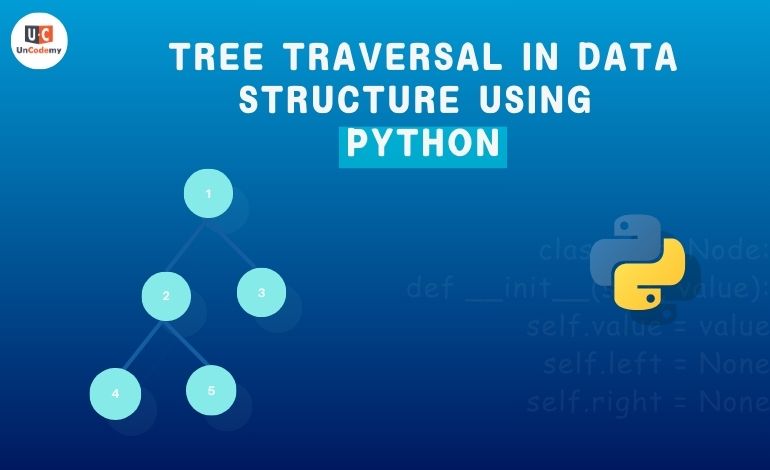Tree Traversal in Data Structure Using Python
Navigating the world of data structures can sometimes feel like venturing into a dense forest. Among these structures,

Navigating the world of data structures can sometimes feel like venturing into a dense forest. Among these structures,


Navigating the world of data structures can sometimes feel like venturing into a dense forest. Among these structures, trees stand tall, and understanding how to traverse them is akin to knowing the lay of the land. In this blog, we’ll explore tree traversal in data structures using Python, breaking down complex concepts into digestible pieces.
“If you can’t explain it simply, you don’t understand it well enough.”
-Albert Einstein
Let’s embark on this journey together.
A tree is a hierarchical data structure consisting of nodes connected by edges. It starts with a root node and branches out into child nodes, forming a structure that resembles an inverted tree. Each node contains a value, and nodes can have child nodes, leading to a parent-child relationship. Unlike linear data structures like arrays or linked lists, trees provide a way to represent hierarchical relationships.
Traversing a tree means visiting all its nodes in a specific order. This process is essential for various operations, such as searching for a value, inserting or deleting nodes, and performing calculations. Think of it as exploring every branch and leaf of a tree to gather information or make modifications.
Tree traversal methods can be broadly categorized into two types:
Let’s roll up our sleeves and dive into some Python code to see how these traversals are implemented.
First, we’ll define a simple binary tree node class:
python
class TreeNode:
def __init__(self, value):
self.value = value
self.left = None
self.right = NoneNow, let’s implement each traversal method:
1. Inorder Traversal: python
def inorder_traversal(node):
if node:
inorder_traversal(node.left)
print(node.value, end=' ')
inorder_traversal(node.right) # Constructing the following tree:
# 1
# / \
# 2 3
# / \
# 4 5
root = TreeNode(1)
root.left = TreeNode(2)
root.right = TreeNode(3)
root.left.left = TreeNode(4)
root.left.right = TreeNode(5)
inorder_traversal(root) # Output: 4 2 5 1 3 2.Preorder Traversal: python
def preorder_traversal(node):
if node:
print(node.value, end=' ')
preorder_traversal(node.left)
preorder_traversal(node.right) preorder_traversal(root) # Output: 1 2 4 5 3
3.Postorder Traversal: python
def postorder_traversal(node):
if node:
postorder_traversal(node.left)
postorder_traversal(node.right)
print(node.value, end=' ')postorder_traversal(root) # Output: 4 5 2 3 1
4.Level-Order Traversal (BFS): python
from collections import deque
def level_order_traversal(root):
if not root:
return queue = deque([root])
while queue:
node = queue.popleft()
print(node.value, end=' ')
if node.left:
queue.append(node.left)
if node.right:
queue.append(node.right)level_order_traversal(root) # Output: 1 2 3 4 5
Applications of Tree Traversal
Tree traversal methods are not just academic exercises; they have practical applications:
While tree traversal is essential for navigating hierarchical data structures, it comes with its own set of challenges. Let’s explore some key difficulties and how they impact performance.
1. Handling Large Trees.
Traversing extensive trees can lead to significant memory consumption and increased processing time. For instance, in a vast binary tree, a depth-first search (DFS) might require deep recursion, consuming substantial stack space. This can be mitigated by using iterative methods with explicit stacks or employing breadth-first search (BFS) to manage memory more efficiently.
2. Stack Overflow in Recursion
Recursive traversal methods, like in-order or post-order traversals, can cause stack overflow errors if the tree’s depth exceeds the system’s stack limit. Consider a deeply nested tree:
python
def inorder_traversal(node):
if node:
inorder_traversal(node.left)
print(node.value)
inorder_traversal(node.right)In such cases, converting the recursive approach to an iterative one using an explicit stack can prevent overflow issues.
Tree traversal plays a crucial role in data structures and algorithm optimization. To help you gain a better understanding, we’ve compiled a list of frequently asked questions with concise explanations.
1. What is tree traversal?
Tree traversal refers to the process of visiting all the nodes in a tree data structure systematically.
2. What are the main types of tree traversal techniques?
The primary types are Depth-First Search (DFS), which includes in-order, pre-order, and post-order traversals, and Breadth-First Search (BFS), commonly known as level-order traversal.
3. Why can recursion cause stack overflow in tree traversal?
Recursive methods add a new frame to the call stack with each function call. In deep or unbalanced trees, this can exceed the stack’s capacity, leading to a stack overflow error.
4. How do iterative traversal methods help with deep trees?
Iterative methods use explicit data structures like stacks or queues to manage nodes, reducing the risk of stack overflow associated with deep recursion.
5. What strategies can optimize tree traversal in large trees?
Optimizations include using tail recursion, implementing iterative methods, and balancing the tree to ensure more uniform depth across branches.
Personalized learning paths with interactive materials and progress tracking for optimal learning experience.
Explore LMSCreate professional, ATS-optimized resumes tailored for tech roles with intelligent suggestions.
Build ResumeDetailed analysis of how your resume performs in Applicant Tracking Systems with actionable insights.
Check ResumeAI analyzes your code for efficiency, best practices, and bugs with instant feedback.
Try Code ReviewPractice coding in 20+ languages with our cloud-based compiler that works on any device.
Start Coding TRENDING
TRENDING BESTSELLER
BESTSELLER BESTSELLER
BESTSELLER TRENDING
TRENDING HOT
HOT BESTSELLER
BESTSELLER HOT
HOT BESTSELLER
BESTSELLER BESTSELLER
BESTSELLER HOT
HOT POPULAR
POPULAR